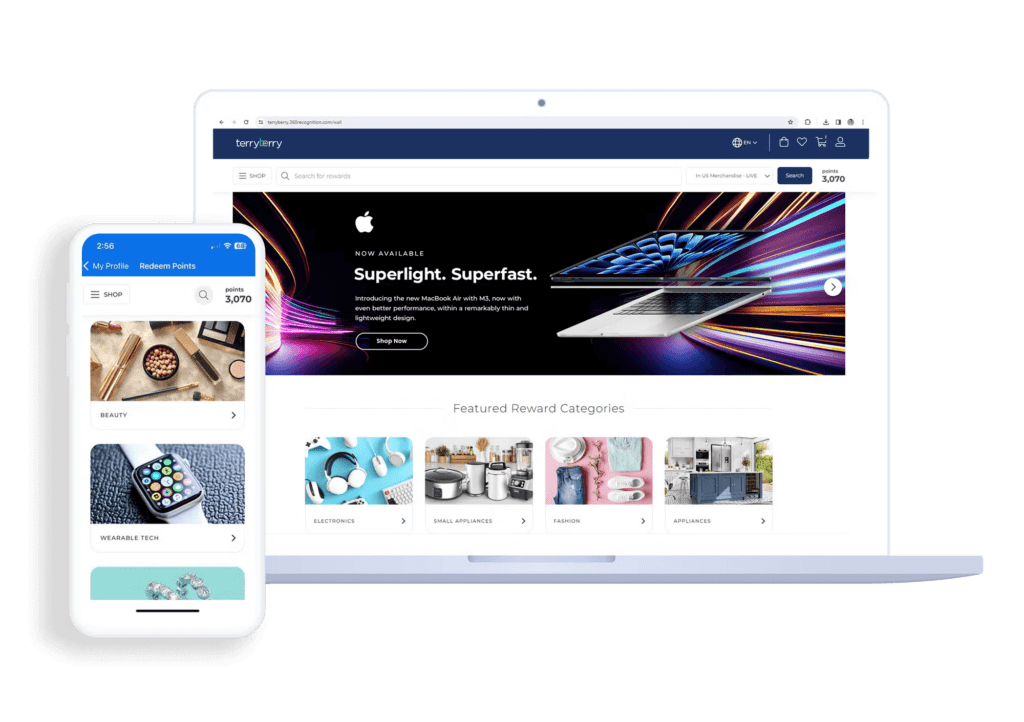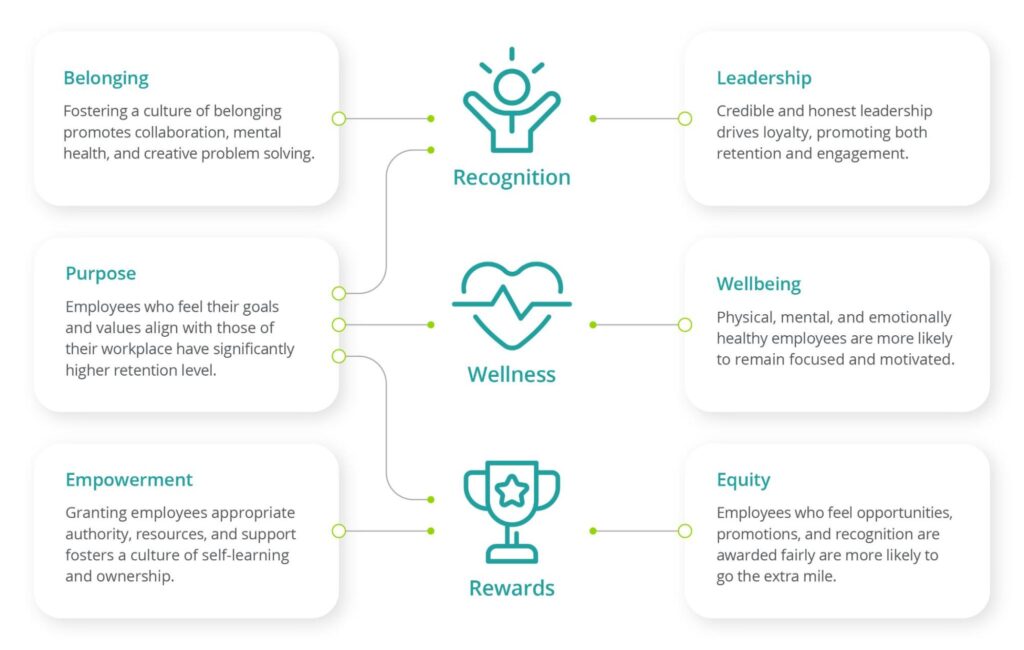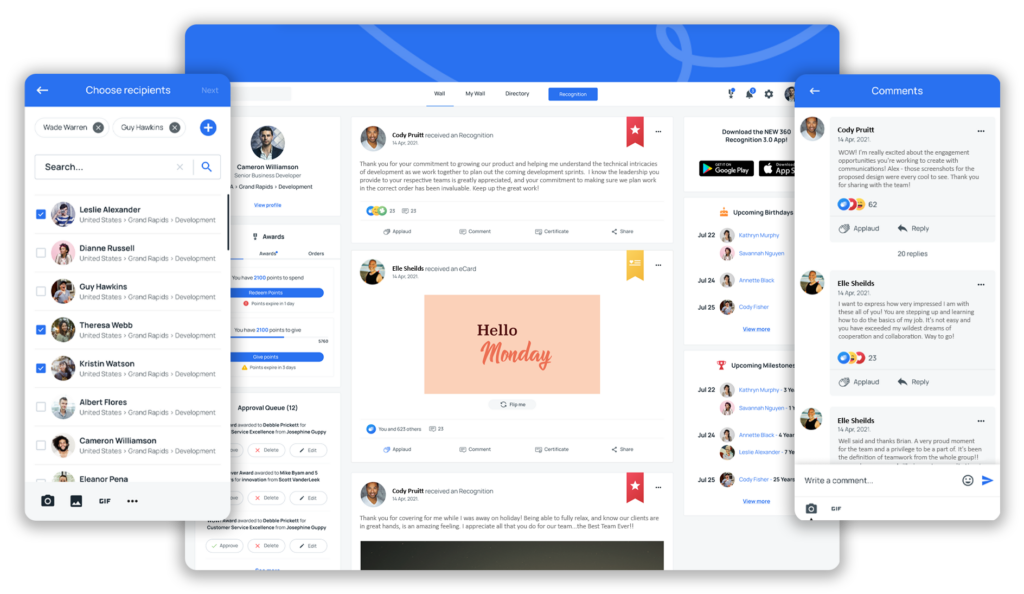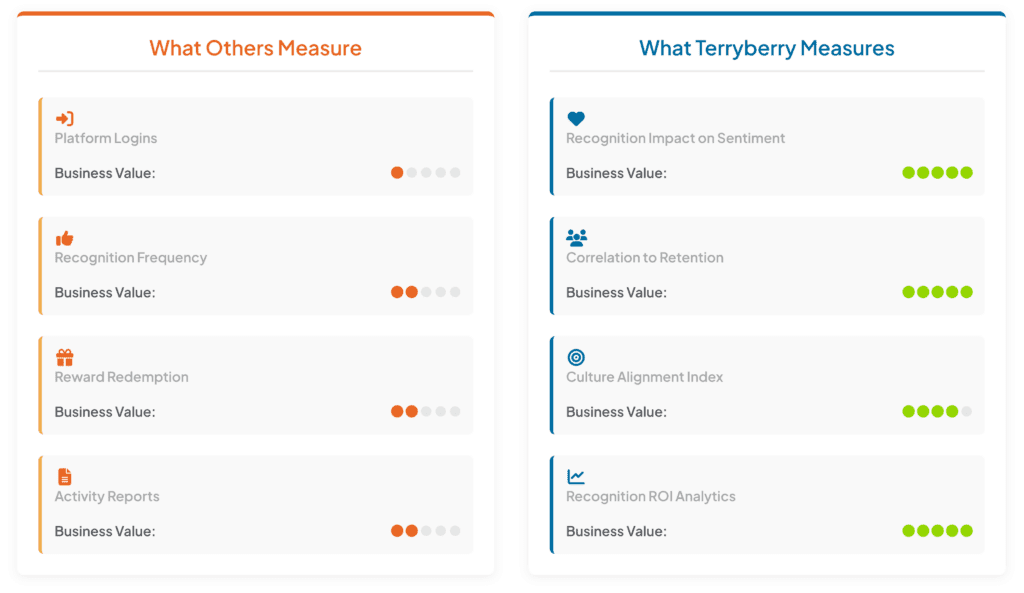July 11, 2025

When recognizing someone’s years of service, getting the wrong gift isn’t actually the biggest mistake companies make. In our experience, what matters most is recognizing people, in the right way, for the right things—rather than reducing service anniversaries to a generic “hey, thanks for sticking around for 3 years!” gesture. That means connecting years of service milestones to an employee’s personal contributions and achievements.
So when someone reaches their third year of service, the moment is about thanking them for consistently motivating their team or going above and beyond in their work. These meaningful recognition initiatives are directly linked to improved employee engagement and retention.
In fact, if retention and engagement are your core objectives, don’t limit yourself to just tracking people’s contributions and achievements. Employee listening can help you uncover the underlying sentiments—positive and negative—affecting retention in your organization.
For example, does your marketing department have the highest average tenure because of great leaders? Are finance hires less likely to reach five years of service because they don’t feel integrated into your company culture?
Understanding these sentiments can help you take action to increase overall retention.
In this guide, we explain:
- How to choose the right awards for your program, the different types of awards to consider, and how to plan which awards and gifts to include at different service milestones.
- The benefits of using a rewards platform for your years of service awards program.
- How to drive retention with employee engagement programs. Learn where your years of service program fits into your company’s broader retention strategy.
Terryberry’s rewards platform offers custom awards, a customizable Premium Rewards catalog, and the largest selection of rewards via Amazon Business. Make service anniversaries special with tailored rewards, offer Prime-like delivery, and ensure you never miss important achievements or milestones. With Terryberry, you can design and launch tailored recognition, wellness, and employee listening programs to improve retention.
How to Choose the Right Service Awards for Your Program
When choosing years of service awards for your program, the main considerations are:
- Budgets: Many companies allocate per-head budgets corresponding to their tenure. So maybe people get plaques on their first anniversaries, but trophies on their third or fifth. You might reserve luxury rewards for employees who have crossed five or ten years of service.
- Where your workforce is located: Having team members abroad can complicate logistics. If you’re shipping awards from here to their destination country, you’ll need to account for international shipping fees and any taxes.
- The recipient’s preferences: If you’re including gifts in your program, consider tailoring them to people’s circumstances and preferences. Or you can leave the choice up to the recipient by using gift vouchers or a points-based rewards platform.
Most service awards programs use custom awards, such as plaques, trophies, and jewelry. Not only can you tailor these awards to the recipient (e.g., name, role, design options), but they can also reflect the year of service as well. For example, you might use different-sized trophies, plaques made of different materials, or different style and color options.
Amteck, a family-owned construction company, partnered with us for a service awards program that used custom jewelry. We manufactured different styles of rings with embedded gemstones. The stones’ colors indicate the employee’s tenure.
Here’s a closer look at the different types of years of service awards available in our catalog:
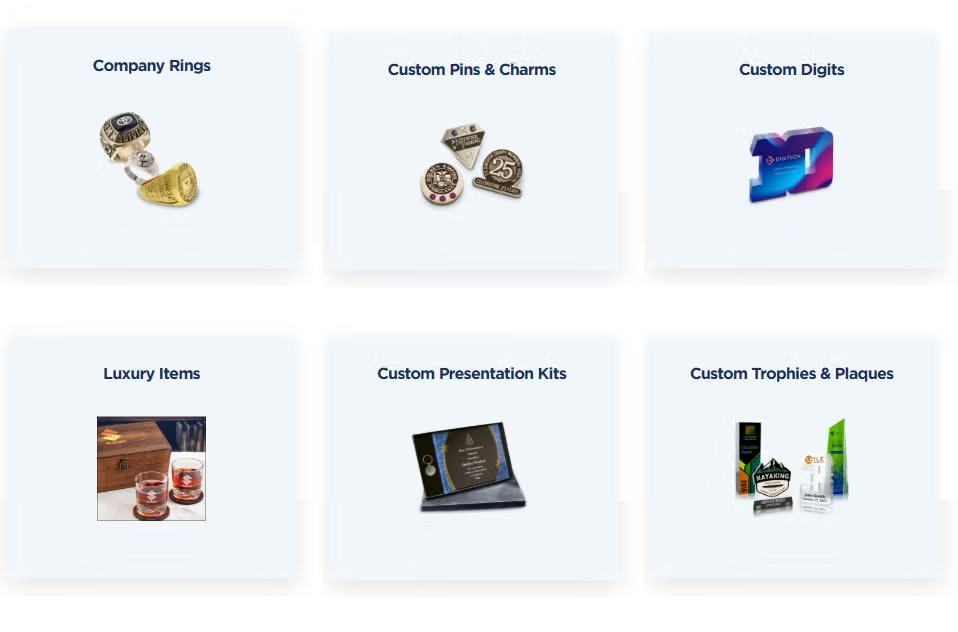
Custom awards aren’t your only option for service programs. Many businesses also include rewards and gifts in their service anniversary programs, such as:
Experiential gifts
Luxury and lifestyle rewards
Self-care and fitness gifts
Company swag
For example, here’s how you could tailor the awards in your years of service program:
- Custom awards: Plaques of different designs for the first and third-year anniversaries. Bronze, silver, and golden trophies of increasing sizes for fifth, tenth, and fifteenth year anniversaries.
- Rewards:
- First year: Basic company swag, like a thermos.
- Third year: Tech gifts, such as AirPods or a smartwatch.
- Fifth year: Luxury gifts, like custom jewelry or high-end watches.
- Tenth year: A paid vacation.
- Fifth year: A paid vacation and luxury gifts.
Alternatively, you could:
- Stick with one type of custom award, and use cosmetic changes to indicate the recipient’s year of service. For example, you can use different embedded gemstones or incorporate special ribbons around your trophies.
- Tailor people’s rewards based on their preferences and circumstances. Is your third-year employee interested in being promoted by their fifth year of service? Maybe the best way to support them is by paying for a certification or a course that helps them upskill.
Effortlessly Scale Your Awards Program(s) with a Rewards System
Most growing businesses use a rewards system to scale their programs because these platforms:
- Automate admin work: Track upcoming service anniversaries, configure rewards for each service anniversary, and automate nomination and approval workflows. You can also place orders for multiple types of rewards in one place, such as custom awards and luxury gifts.
- Help you give employees gifts they’ll truly appreciate: Are you considering offering gifts, like luxury or travel rewards, alongside your custom service awards? Using a points-based system means you don’t have to find the perfect gift for each employee. Awarding them points gives them the freedom to choose their favorite rewards.You can configure rewards platforms to determine when people receive points and how many they get in each instance. For example, for a service awards program, you can use a tiered system. So, people are allocated more points for longer years of service.
If you’re interested in using a rewards system for your program, here’s why over 40,000 businesses chose ours.
1. We Offer the Largest Selection of Awards and Rewards on the Market
Terryberry is one of the few rewards platforms that also manufactures and fulfills custom awards. We’ve been manufacturing custom jewelry since 1918, and other types of custom awards (trophies, plaques, etc.) for decades.
Thanks to our partnership with Amazon Business, we also offer the largest selection of rewards in the market. You can also create custom shopping portals via Terryberry’s Premium Rewards catalog by selecting specific categories, such as merchandise from top brands, electronics, travel and lifestyle rewards, charitable donations, and once-in-a-lifetime experiences.
2. Fast and Painless Domestic and International Fulfillment
If you’re based in the U.S.:
- We’ll ship your custom awards to your desired locations with instructions on how to distribute them.
- Enjoy Prime-like delivery with no markup through Amazon Business on any rewards you order.
If you’re shipping internationally:
- Ship rewards from Terryberry’s Premium Rewards catalog without worrying about hefty taxes and international shipping fees, thanks to our network of over 100 local fulfillment partners in different countries.
3. Combine Rewards with Employee Engagement Programs
With Terryberry, you can launch and tailor different types of employee engagement programs, including employee listening, recognition, and wellness. With our rewards system automating the manual work involved in giving rewards, your HR team and managers are free to prioritize more strategic tasks. They can focus on collecting feedback about your programs, make changes to improve performance, and explore additional programs.
How to Drive Retention with Awards & Employee Engagement Programs
To improve retention with your services awards program, it’s crucial to:
- Think beyond rewards and about recognition. While handing out awards is a nice gesture on its own, connecting these moments to the recipient’s achievements is key to reducing churn. Employee recognition is the single most effective driver for motivating employees to do “great work,” and companies with formal recognition programs boast 31% less voluntary turnover.
- Understand the factors impacting people’s decisions to stay at your company or to leave. Do you know why employees have stayed at your company for three years, or five, or ten? Service milestones are an opportunity to reflect and say, “Great, we’ve kept this person happy for three years now. How do we make sure they’re happy for another two, and then another five?”
In this section, we show you how to:
- Track people’s important contributions and achievements, so you can recognize them
- Measure and quantify the various factors impacting retention while uncovering trends related to people’s years of service and retention
- Make your service awards program impactful with tailored recognition moments
- Increase retention with tailored employee engagement programs, and measure each program’s performance and impact
1. Employee Listening: Uncover What Drives Employees to Contribute & Stay
An employee listening program can help you:
I. Understand employees' contributions and achievements to plan ahead for service anniversaries
Smaller companies may get by with an informal listening program, where someone from HR collects information from managers and employees about their peers. They might also ask people to self-evaluate and highlight their own achievements.
But informal programs don’t scale well, so growing companies inevitably need a formal system. A formal program can involve any (or all) of the following:
- Collecting feedback from managers about their employees’ upcoming service milestones: They can tell you more about the employee and suggest which contributions and achievements to highlight on their service anniversary.
- Collecting feedback from multiple sources: Survey the award recipient’s peers, their manager, and maybe the recipient with a self-evaluation survey. You’ll obtain a more comprehensive picture of the employee’s impact on the company and those around them.
- Combining insights from a year-round recognition program: Year-round recognition programs, such as peer or manager recognition, consistently celebrate people’s contributions and daily wins.If you’re running one of these programs, then you can check the contributions and achievements each employee has been recognized for throughout the year(s). For example, maybe Susan from HR was consistently recognized for demonstrating your company’s core values of “integrity” and “empathy.”
II. Uncover the factors impacting employee engagement and retention
You can use service milestones to help measure your overall retention strategy’s success. If a healthy percentage of employees are progressing from their first year to their third, and then to their fifth and tenth, you’ll know your strategy’s working.
If you’re planning to improve retention across the company, your strategy can’t end at celebrating people’s achievements. Various factors, beyond feeling valued, impact people’s decisions to stay. For example, someone might leave after their fifth anniversary because they feel there’s no room left to grow. Maybe others leave after their second year because they struggled to connect with their peers.
Successful retention strategies track people’s sentiments towards their jobs, peers, managers, and workplace culture to address any gaps proactively. Some companies use various surveys with disparate data to understand these sentiments, including:
- Manager review surveys to learn how people feel about their managers.
- Stay surveys to collect people’s stated reasons for remaining at your company.
- eNPS surveys to gauge which groups of employees are at a greater risk of leaving.
- Employee satisfaction surveys to capture employees’ sentiments towards specific initiatives, projects, people, and policies.
While these surveys offer a broad understanding of your workforce’s sentiments, they don’t specifically help you predict retention. For example:
- The insights from stay surveys are limited because:
- They rely on self-stated reasons, which aren’t always accurate.
- People’s sentiments and needs evolve over time—just because someone stayed for three years doesn’t guarantee they’ll be around for another three.
- While employee satisfaction and manager review surveys reveal people’s sentiments, they don’t quantify the impact of these sentiments on retention.
To really understand why some people choose to stay or leave, companies must measure the impact of their culture. People’s relationships with their peers and managers, the opportunities they have in your organization, and their alignment with your goals—these factors all shape your culture.
We set out to understand people’s underlying motivations for staying or leaving by developing a culture model in collaboration with three independent PhD researchers. The culture model identifies six factors that shape your company’s culture and directly impact employee engagement and retention. Known as engagement indicators, these factors are:
- Belonging
- Leadership
- Purpose
- Wellbeing
- Empowerment
- Equity
By monitoring and quantifying these factors, you’ll know what’s motivating employees to stay and what may push them to leave. For example, maybe a specific cohort—let’s say employees aged 24–35—lack a strong sense of equity, but they have strong sentiments of belonging, well-being, and leadership. Here, equity is negatively impacting engagement, while the other three factors are encouraging it.
We realize that “strong” is a vague term, and quantifying the impact of each factor is important. That’s why our engagement baseline survey—which assesses employees across these six indicators—assigns Likert scores (which can be positive or negative) to each indicator. For example, maybe your workforce scores +10 in leadership overall, but -3 in belonging, indicating that people have positive feelings about the company’s leadership but don’t feel connected to its culture.
After you’ve conducted the survey, you can use your survey tool’s filters to analyze trends specific to different cohorts, such as age, department, gender, and tenure. You can identify gaps specific to people’s years of service using the “tenure” filter. Look for trends across different milestones, such as 3, 5, 10, and 15 years.
For example, are equity scores lower for people with 3 years of service than those with 5 and 10 years of tenure? What’s the difference in the average eNPS of employees with 3 and 10 years of service?
2. Taking Action: Recognize Contributions and Provide the Support People Need
Your employee listening program should reveal the insights you need to: (1) transform years of service anniversaries into meaningful celebrations of people’s contributions and achievements, and (2) decide which employee engagement programs and initiatives to launch to improve retention across your organization.
To achieve these goals, there are three main courses of action to consider:
- Developing your years of service awards program
- Boosting retention by supporting your service awards program with year-round recognition programs
- Addressing the factors contributing to employee engagement with different engagement programs
Regardless of the type of engagement program you launch, there are four key considerations for making sure it drives results:
Consideration #1: Connecting your program to strategic objectives
When developing engagement programs, make sure you have a clear plan for how they’ll drive cultural change. For example, let’s say your years of service program:
- Recognizes each employee’s contributions and achievements throughout their tenure: Here, you’re instilling a shared sense of purpose by appreciating people’s commitment to driving company goals forward.
- Engages senior executives for award ceremonies: You’re making employees feel seen and valued by your company’s leadership.
Consideration #2: Engaging leadership
When leaders actively participate in engagement programs, it signals to the entire workforce that these efforts matter. But symbolic involvement or behind-the-scenes admin work isn’t enough—programs succeed when leaders are visible and hands-on.
- Years of service awards programs: Managers can make anniversaries more meaningful by highlighting employees’ contributions, achievements, aspirations, and peer relationships. Involving leaders shows employees that their work and loyalty truly matter—whether it’s senior managers presenting awards, the CEO sending personal notes for three-year milestones, or executives hosting five-year honorees for lunch.
Consideration #3: Motivating people to participate
For most engagement programs, such as wellness, learning and development, or year-round recognition programs, you can maximize participation by:
- Motivating people with the right incentives: The main considerations here are the type of programs, your employees’ preferences, and the allocated budget for employee rewards. For example, while custom awards and dinners with executives can be effective for years of service programs, self-care rewards may be a better fit for a wellness program. For career development programs, maybe you’d offer to cover the tuition for specific certifications.
- Removing any barriers: Various factors can impact how easily some employees can participate in an engagement program. For example, if most of your workforce is on-site and part of it is remote, you’ll need to account for both when designing service anniversaries.
For service awards programs, there’s a slight difference in how you approach participation. The most critical attendees are the recipients of the awards, so you’d want to aim for 100% of them to attend. The best way to encourage attendance is by celebrating people’s contributions and rewarding their hard work.
Consideration #4: Measurement and continuous improvement
We discuss how to measure your program’s impact on retention and identify any gaps in the next section.
Service awards programs are a type of “milestone” recognition program. As the name suggests, they celebrate people for achieving specific milestones, such as years of service, project completions, promotions, or meeting specific performance goals. But there are also “always-on” recognition programs, namely:
- Social recognition programs: These year-round programs encourage employees to celebrate each other’s daily wins, contributions, and achievements. They’re useful for driving cultural change, such as connecting a distributed workforce, cultivating core values, or creating a shared sense of purpose and belonging.
- Manager recognition programs: Like social recognition programs, you can run year-round manager recognition programs to shape your company’s culture. They can address gaps in employee-manager relationships uncovered by your listening program—e.g., maybe the baseline survey reveals low leadership scores, or employees rate some managers low in manager evaluations.
In our experience helping more than 40,000 companies launch employee engagement programs, organizations observe the best results when they use different, complementary programs. For example, some companies might start with social recognition and eventually introduce a years-of-service awards program later. Or vice versa.
Here’s how one bank with over 200 employees and multiple locations cultivated a shared sense of purpose and belonging with a social recognition program rooted in core values.
Chelsea Groton Bank’s “Acorn Rewards” Program
Chelsea Groton Bank is the largest mutual bank in Eastern Connecticut, operating across 15 locations with over 200 employees. When the bank reached out to our team, they already had a successful milestone awards program and a strong workplace community.
But Chelsea Groton’s leadership wanted to celebrate people’s day-to-day contributions and shape the organization’s culture by promoting its seven core values: being innovative, collaborative, trustworthy, professional, knowledgeable, versatile, and positive. They wanted a social recognition program that made employees across locations feel connected to each other’s achievements and contributions.
With Terryberry’s help, Chelsea Groton Bank launched the “Acorn Rewards” program. The program:
- Connected recognition to strategic objectives. Employees can award each other a “Purple Acorn Award” for demonstrating a core value or going above and beyond in their work.
- Motivated people to participate—by demonstrating core values—using a tiered rewards system. For example, participants who collect 10 Purple Acorn Awards receive a themed plush toy—the “Happy Squirrel.” For every additional 10 Purple Acorns collected, employees receive points that can be redeemed for luxury and lifestyle rewards.
- Leadership involvement: Employees who receive the highest level of recognition in the program—the Mighty Oak Award—are invited to attend a senior team meeting, where they’re recognized in front of their manager and senior leaders.
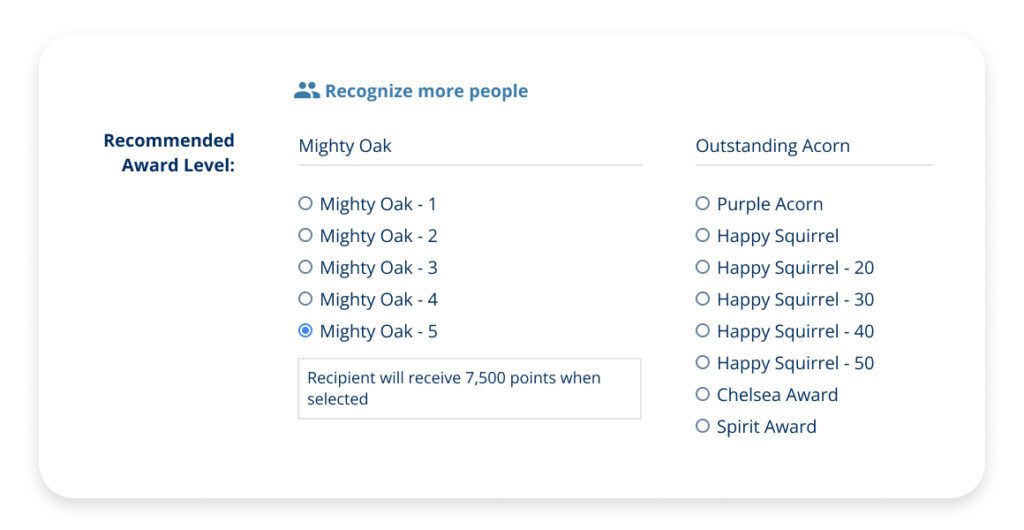
Chelsea Groton used Terryberry’s Recognition analytics to measure monthly participation. They were pleased to discover that participation in their Acorn Rewards program is more than double the industry average for financial organizations.
Beyond Recognition: Launch Supportive Employee Engagement Programs
While recognition programs are powerful tools for boosting employee engagement and retention, they don’t cover every front. Your listening program might reveal some gaps that are better addressed by other programs, for example:
- Wellness programs can help you improve people’s physical, mental, and emotional well-being. Various types of programs can improve people’s well-being. For example, expert-led seminars and courses that tackle common workplace challenges, such as maintaining work-life balance or setting boundaries with peers. More immersive programs, like activity challenges, encourage people to meet specific fitness or wellness goals. Step challenges, sleep tracking, and even hydration challenges fall under this category.
- Learning and development (L&D) programs can address people’s feelings of empowerment and equity. If your baseline survey reveals low scores for these engagement indicators, start by investigating the cause with follow-up surveys. If you learn that people don’t feel like they have opportunities to upskill or get promoted, consider investing in these programs.
Unless the gaps revealed by your employee listening program impact your entire workforce, you don’t necessarily have to roll out organization-wide engagement programs. Many companies achieve their employee engagement and retention goals by supporting one or two core, organization-wide programs—such as years of service and social recognition—with smaller, tailored initiatives.
For example, if your employee listening program reveals that equity scores are low only for employees with three to five years of service, then your L&D program might only need to address that group. Maybe your drill-down surveys reveal that equity scores are low for this group specifically because their managers haven’t designed relevant career pathways.
Similarly, let’s say you’re six months into a manager recognition program and discover that the “belonging” scores of your most recognized employees are dropping, indicating burnout. You can launch a small, tailored well-being program to specifically address their needs.
Develop a comprehensive, end-to-end employee retention strategy using our actionable framework for reducing employee turnover.
3. Measure Your Program’s Performance and Impact
Once your programs are live, how do you know if they’re working? Are they positively impacting the specific engagement indicators you aimed to improve? Is employee retention improving overall? Can you justify the ROI of these programs to leadership?
You can best answer these questions using three sets of data:
- Insights from your employee listening program, including findings from satisfaction and stay surveys, engagement indicator scores, and eNPS. While satisfaction surveys are useful for understanding changes in sentiments over time, they’re less helpful for predicting engagement and retention.Combining engagement indicator scores with eNPS reveals the cohorts most and least likely to leave your organization, as well as the underlying factors influencing their decisions.
- Participation metrics from your engagement program. You can’t measure a program’s impact without knowing who’s participating. More specific insights, such as your most and least recognized employees or the number of people who’ve reached specific years of service milestones, can help you uncover trends.
- Broader HR metrics, including absenteeism, voluntary turnover, and your retention rate. While these factors speak to your organization’s broader retention and engagement strategy, they don’t prove the impact of specific programs. You’ll need the other two sets of data to connect improvements in broader HR metrics with the impact of specific engagement programs.
Combining participation insights with employee listening data can help you capture specific insights such as:
- In your social recognition program, are your least recognized employees scoring higher in some engagement indicators than your most recognized ones? What’s the corresponding impact on eNPS?
- The impact of manager participation in recognition programs. You can compare eNPS and engagement indicator scores for teams with highly participatory managers vs. those with managers who participate the least.
- Are there trends in engagement indicator scores relative to an employee’s tenure? For example, do employee cohorts with three and five years of service have different equity scores? Is there a connection between well-being scores and tenure? While these insights won’t reveal the impact of a specific program, they demonstrate the overall impact of your retention strategy.
- Of the cohorts with the lowest eNPS scores, which engagement indicator scores are still low? For example, let’s say a specific department originally scored low in purpose, belonging, and leadership. After your social recognition program has been live for three months, the department’s leadership score is still low, but purpose and belonging scores have increased. In this case, you might need to consider:
- Involving leaders more in your social recognition program. For example, maybe employees who reach a certain threshold of recognition are invited to lunch with senior executives.
- Launching a manager recognition program to improve employees’ relationships with their managers.
Don’t be alarmed to discover gaps in your employee engagement programs—no single program addresses all the factors impacting retention. Chelsea Groton Bank’s milestone program was a success, but they still launched the Acorn Rewards social recognition program to cultivate their core values. Measuring each program’s performance tells you which fronts are now covered so that you can address any remaining gaps with supporting, tailored programs.
Bring Awards, Recognition & Employee listening Together with Terryberry’s Integrated Employee Engagement Platform
You can use Terryberry’s integrated employee engagement platform to uncover the factors impacting employee retention, launch tailored employee engagement programs, and measure their impact.
Whether you’re launching a service awards or a wellness program, Terryberry makes it easy to design programs around strategic goals, integrate your preferred rewards, and keep leaders and employees engaged.
Better Understand Your Workforce with Employee Listening
Launch ready-made surveys from Terryberry’s survey library to measure employee engagement, satisfaction, and retention. Uncover people’s sentiments towards specific programs, policies, and peers. Capture deeper insights with drill-down surveys, use AI to rapidly launch surveys for niche scenarios, and automate follow-ups with Terryberry’s employee listening tool.
Boost Retention & Engagement with Tailored Employee Engagement Programs
Develop, launch, and scale tailored rewards, recognition, and wellness programs that drive your strategic objectives. Cultivate core values, bring distributed teams together, and ensure your workforce is connected to your company’s leadership and goals.
With Unified Analytics, Know What’s Working—and Where to Improve
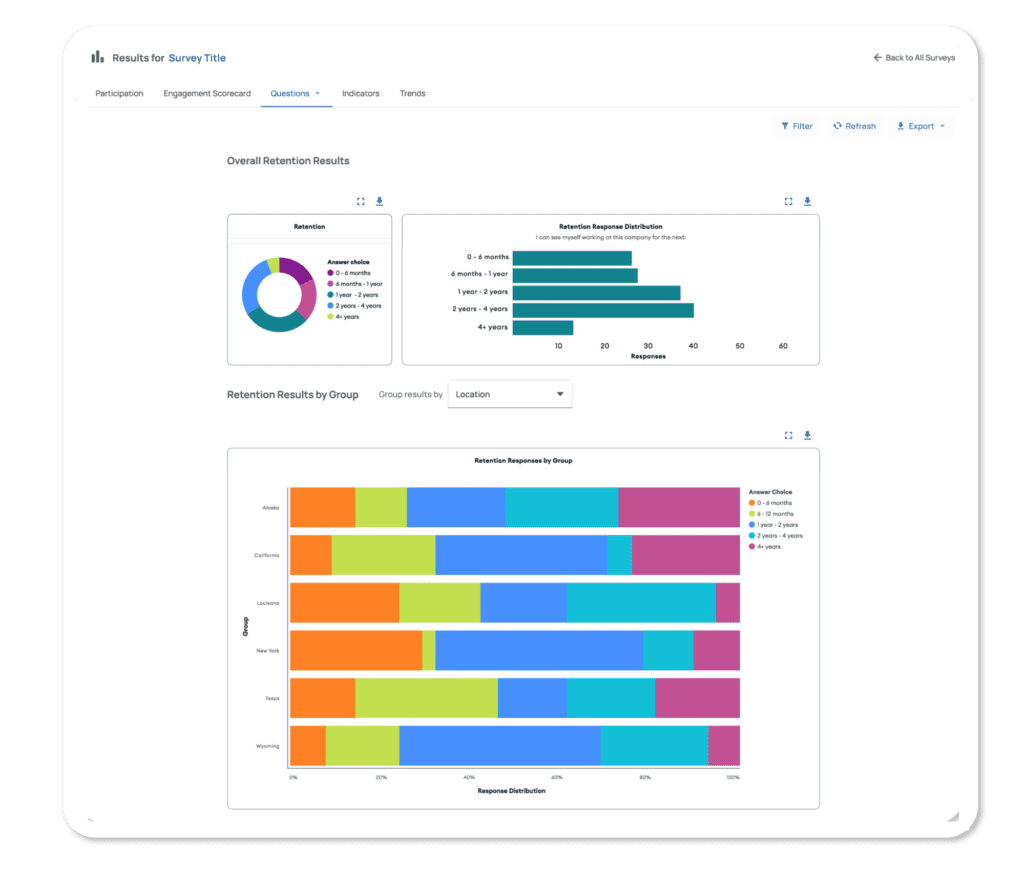
Measure each engagement program’s performance with detailed participation analytics. Prove your program’s impact on employee engagement and retention by combining these insights with employee listening data in a single, integrated platform.
Ready to boost retention with tailored engagement programs? Schedule a demo with our team today.
